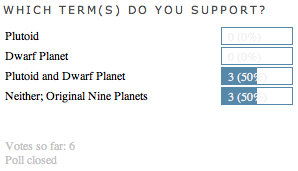
Pluto with its moons, Charon, S/2005 P1, and S/2005 P2
Image: NASA/ESA
About two years ago, the International Astronomical Union (IAU) made a big decision. There are going to be eight planets, and Pluto was not one. For Pluto, and also for Ceres and Eris, a new category was created. Pluto, Ceres, and Eris are now considered dwarf planets, a round celestial body orbiting the sun which has not cleared the area around its orbit. In addition,Image: NASA/ESA
dwarf planets cannot be satellites. However, on June 11, the IAU has made another decision.
Pluto is now also considered a plutoid. By the IAU's definition: "Plutoids are celestial bodies in orbit around the Sun at a semimajor axis greater than that of Neptune that have sufficient mass for their self-gravity to overcome rigid body forces so that they assume a hydrostatic equilibrium (near-spherical) shape, and that have not cleared the neighborhood around their orbit." Basically plutoids are dwarf planets that are outside the orbit of Neptune. This currently includes Pluto and Eris, but the IAU expects more planets to become plutoids in the future. There are already numerous objects that are candidates to become plutoids. However, this new categorization has not come without controversy.
The old decision to remove the planet status from Pluto was very cont
roversial, and many believe this new decision is just creating more disagreement. Some think that this is just creating more confusion, by introducing another term in the already big list of existing terms for the same outer solar system objects.

So, I am offering a question to you, the reader. Do you support the plutoid term? Vote on the poll on the sidebar at right. The poll will close on August 1, 2008, so vote now.
Update, Poll Results: With a total of six votes in the poll, three people supported the Plutoid and Dwarf Planet terms, while three other people preferred the original nine planets.

I think plutoid is the best term.
ReplyDelete